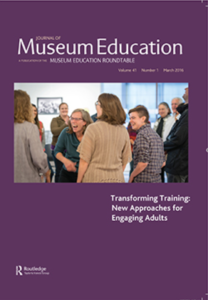Docents 2.0
My cell phone has been prompting me daily now for a couple of weeks (or longer?) to update it to the newest version of its operating system. Each time, I tell it to remind me later. When I stop and ask myself why I keep putting it off, there are a couple of reasons: running the update takes time away from my using the phone to do all the important things I depend upon it to do (email, calendar, social media, online searching and shopping, etc.). After the update, I will have to re-learn how to use it because it will look and feel different than what I have grown accustomed to since the last update. And, based on previous experiences with this kind of thing, I am afraid that the update will go badly, and I’ll be left with a phone that’s useless.
- Time
- Effort
- Discomfort
- Stress
- Fear
- Uncertainty
These natural and normal feelings in the face of change can be unpleasant, so it’s not surprising I repeatedly put off the update in order to avoid them. I tell myself my phone is working fine as it is and keep declining its persistent reminders. Similarly, it should come as no surprise that some docents, who are the most talented, intelligent and deeply committed of volunteers, resist recommended updates to gallery teaching “operating systems” for engaging adults in learning in museums.
In particular, the resistance seems to be with the shift over the past two decades or so from a traditional lecture model to a more conversational one. Talking with instead of at your audience leaves much more to chance. Letting your audience’s interests lead you to the types of information you share means you may not get to talk about the things you really love. What if the audience wants to talk about an aspect of the artwork, scientific principle, or historical period that you don’t feel confident discussing? By saying we need to do something differently, does the field mean that what we’ve been doing all these years was wrong? What if the audience reveals a gap in your knowledge? What if the new teaching strategy you learned at docent training falls flat when you try it out on your next tour? These are all real and valid fears faced by volunteer docents and paid educators alike.
Part of the reason my phone’s update is hard, is that it’s thrust upon me without warning. It feels forced. Eventually, the daily reminders will wear me down, and I’ll give in and run the update. I imagine a similar feeling of abruptness when docents are asked to adopt new approaches but don’t have a firm grounding in the larger educational or institutional contexts that led to the change.
With our most recent docent class at the Saint Louis Art Museum, we didn’t begin with curatorial presentations about the museum’s impressive and exciting encyclopedic collection. We began the two-year training with readings and discussions about museum audiences, learning in museums and an introduction to the museum’s ambitious, audience-focused strategic plan. Docents were assigned to spend time in the galleries observing visitor behavior and talking with visitors about their motivations and experiences. The museum’s senior leadership joined the class to share the big picture about current and future initiatives and to take questions. This approach had the potential to be disappointing to the new group of 35 eager, art-loving, docents-in-training. However, during informational sessions and one-on-one interviews with each of potential docent, Museum staff was explicit with our expectations, stating, “Docent training is not an art history course. If that’s what you’re looking for, we’d recommend you take advantage of the offerings at one of our many excellent local colleges and universities.”
What about those docents trained before, in subtly or dramatically different ways? Is their training invalid, are they at risk of becoming obsolete? Those fortunate enough to have long-standing docent programs—the Saint Louis Art Museum’s Docent Program celebrates 52 years in 2016—know that docents with the longest tenure are often the most adaptable and eager adopters of, and cheerleaders for, new approaches. They are typically highly respected by their docent peers, making them excellent partners in implementing new approaches. With the ongoing professionalization and evolution of docent programs, we’ve come to ask and expect a lot of our docents. I have asked myself on more than one occasion if we’re asking and expecting too much from volunteer educators? Yet, without them, our ability to deliver our programs would be significantly reduced.
 It’s important to explicitly acknowledge that, although the educators and approaches may have changed, the same museum trained all of its docents over the years. Share not only what the desired changes are but also why, and plan for adequate time and training to overcome any initial anxiety or discomfort. Communicating regularly, not just when you’re making changes, can also be a huge help. This may look different depending on the size of your museum and docent corps and your role in the organization. I don’t manage the day-to-day of the Docent Program, so my approach is to try and help docents see how what they do connects to larger institutional goals and initiatives. I’ve made a point of reporting about broader issues in the field to SLAM’s 145 active, associate (in training) and honorary docents during their monthly meetings when I return from conferences. Later this month, I’ll begin hosting quarterly lunches with small groups of docents, during which I hope to hear from them about their experiences and to share with them about the bigger picture in Learning & Engagement. In collaboration with the Docent Advisory Board, we’ve begun hosting periodic Q&A sessions with senior staff, which all docents are encouraged to attend. I make a point to practice what I preach and get out into the galleries with docents to work together. Shared vulnerability can have a great team-building effect.
It’s important to explicitly acknowledge that, although the educators and approaches may have changed, the same museum trained all of its docents over the years. Share not only what the desired changes are but also why, and plan for adequate time and training to overcome any initial anxiety or discomfort. Communicating regularly, not just when you’re making changes, can also be a huge help. This may look different depending on the size of your museum and docent corps and your role in the organization. I don’t manage the day-to-day of the Docent Program, so my approach is to try and help docents see how what they do connects to larger institutional goals and initiatives. I’ve made a point of reporting about broader issues in the field to SLAM’s 145 active, associate (in training) and honorary docents during their monthly meetings when I return from conferences. Later this month, I’ll begin hosting quarterly lunches with small groups of docents, during which I hope to hear from them about their experiences and to share with them about the bigger picture in Learning & Engagement. In collaboration with the Docent Advisory Board, we’ve begun hosting periodic Q&A sessions with senior staff, which all docents are encouraged to attend. I make a point to practice what I preach and get out into the galleries with docents to work together. Shared vulnerability can have a great team-building effect.
I’ve spent my entire museum career working with docents. When I was fresh out of grad school and hired to establish a new corps of evening and weekend volunteer guides at the Minneapolis Institute of Art, I was in the same position as the new guides. We were all brand new, without preconceived notions of what gallery teaching was supposed to be, without a grounding in learning theory or the history of docenting in museums. Together, we discovered the theory and practice of gallery teaching and learned about the museum’s collection. Fast forward 16 years, and I found myself in a new city in a new museum, with an equally committed and enthusiastic group of docents. A new training class was beginning just as I arrived, and we too were in a similar place of discovery. How can we continuously cultivate this shared spirit of inquiry, partners in discovery and openness to change?
One obvious shift is to make deliberate changes in recruitment strategies. Recruit for Docent 2.0 skills: curiosity, flexibility, open-mindedness, communication skills, social-emotional intelligence. A background in the subject matter is nice, but not necessary. Be explicit and clear in defining the role of docents at your museum. Use interviews with potential docents to redirect individuals who might be better suited to other volunteer opportunities within the organization. Refer those whose primary or singular interest is learning the subject matter to a local college or university course. Be disciplined in your search to find volunteers with a balanced interest in becoming experts in subject matter and gallery teaching. Make it clear that ongoing training and evaluation are part of the deal. The initial docent training is just the beginning…be prepared for regular updates.
And be sure to check out the March 2016 issue of the Journal of Museum Education on transforming docent training programs and the companion Reader Guide and Training Program Audit.
Amanda Thompson Rundahl is Director of Learning & Engagement at the Saint Louis Art Museum. She is also a member of the Museum Education Roundtable Board of Directors.

